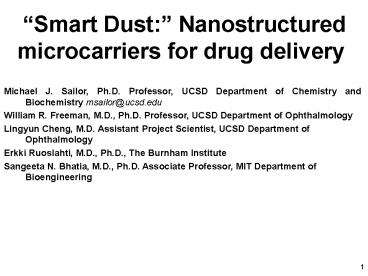Smart Dust: Nanostructured microcarriers for drug delivery - PowerPoint PPT Presentation
1 / 23
Title:
Smart Dust: Nanostructured microcarriers for drug delivery
Description:
Smart Dust: Nanostructured microcarriers for drug delivery – PowerPoint PPT presentation
Number of Views:327
Avg rating:3.0/5.0
Title: Smart Dust: Nanostructured microcarriers for drug delivery
1
Smart Dust Nanostructured microcarriers for
drug delivery
Michael J. Sailor, Ph.D. Professor, UCSD
Department of Chemistry and Biochemistry
msailor_at_ucsd.edu William R. Freeman, M.D., Ph.D.
Professor, UCSD Department of Ophthalmology Lingyu
n Cheng, M.D. Assistant Project Scientist, UCSD
Department of Ophthalmology Erkki Ruoslahti,
M.D., Ph.D., The Burnham Institute Sangeeta N.
Bhatia, M.D., Ph.D. Associate Professor, MIT
Department of Bioengineering
2
2 technologies for controlled drug delivery to
the eye
Unidirectional episcleral plaques use a
nanostructured template to prepare a polymeric
material that can be sewn onto the back of the
eye. The plaque has a designed nanostructure
that can be used to control the rate of release
of the drug.
Encoded microparticles use a nanoporous Si or
SiO2 material. Methods to load, seal, and trigger
release of small molecule, peptide, or
protein-based drugs have been developed.
Above Photonic color code changes when particle
releases payload. Right Porous Si
micro-particles in the rabbit eye.
3
Smart Dust photonic crystal particles
- Michael J. Sailor, UCSD
- Design a mother ship nanostructure to carry and
release a cargo or perform a diagnostic test - Build a code
- Load a drug
- Target the nanostructure to a desired location
- Monitor the nanostructure in-vivo
Smart Dust
Ophthalmoscope image of porous Si photonic
crystals (green color) in the intravitreal region
of the rabbit eye. These particles are the size
of the diameter of a human hair. Courtesy William
R. Freeman, M.D. and Lingyun Cheng, M.D., Shiley
Eye Center, University of California, San Diego
4
Porous Silicon Synthesis
Electron microscope image of porous Si. Side
view of porous Si electrochemically etched into a
single crystal Si wafer.
20 mm
Background Properties of Porous Silicon
Canham, L., Ed. EMIS Datareviews, INSPEC
London, 1997 Vol. 18.
5
Pore size is controlled electrochemically
- Depends on
- Current density
- HF concentration
- Electrolyte composition (usually ethanol, but
other organic solvents have been used) - Dopant type, and dopant concentration
- Current Density for samples at right
- 1.5 x 1.5 mm, 150 mA/cm2
- 5 x 5 mm, 295 mA/cm2
- 5 x 5 mm2, 370 mA/cm2
- 5 x 5 mm2, 440 mA/cm2
- 5 x 5 mm, 515 mA/cm2
- 5 x 5 mm2, 600 mA/cm2
6
Range of Accessible Pore Sizes
7
Photonic Crystals-color from a nanostructure
Porous Si multilayer
2 mm
1 mm
PARKER, A. R., et.al., J. Exper. Biol. 1998 201,
1307-1313.
8
Modulation of pore dimensionsusing current
modulation
Pt
Porosity
HF/Ethanol
Current
Silicon
Time
AC
Background Lehmann, V. Electrochemistry of
Silicon (Wiley-VCH, Weinheim, Germany, 2002).
9
Encoding strategy
Berger, M. G.,et al., Thin Sol. Films 1997, 297,
237-240 Meade, S. O.et al. Adv. Mater. 2004, 16,
1811-1814.
10
Complicated codes can be placed on a particle
Adv. Mater. 2004, 16, 1811-1814.
11
Microdroplet patterning to produce a composite
photonic crystal
Can encapsulate drugs, attach targeting moieties
Li, Y. Y. Kollengode, V. S. Sailor, M. J. Adv.
Mater. 2005, in press.
12
Opening pores to load a drug
Langmuir 2004, 20, 11264-11269.
13
Chemistry can change rate of release of
dexamethasone from porous Si
H-terminated material completely releases
dexamethasone after 2 hours, corresponding to
complete dissolution of the porous Si layer.
After 7 hours only 50-60 of the drug is released
from the more stable hydrosilylated material.
After an initial 2-hour burst, these
hydrosilylated samples steadily released drug for
a period of 3 days.
Langmuir 2004, 20, 11264-11269.
14
Polymer imprints from 1-D photonic crystals
In situ polymer.
hydrolysis
Polymer-based Photonic film
Electropolished PSi
Polymer-PSi Composite
Etching conditions p Type Si wafer, HFEtOH
31 solution 100
mA/1.3 cm2 250 mA/1.3 cm2
2 sec intervals 50 repeats
Electropolishing conditions HFEtOH 114
solution
22 mA/1.3 cm2
2 min
Li, Y. Y. et al. Science 299, 2045-2047 (2003).
15
Flexible 1-D photonic crystals
Porous Si/polynorbornene composite film held
between two pairs of tweezers, showing the
mechanical stability of the materials
Yoon, et. al. Chem. Commun. 2003, 680-68.
16
Monitoring drug delivery with a biocompatible
polymeric photonic crystal
Measurement of degradation of polylactide rugate
peak as a surrogate for the delivery of caffeine
(pH10, aqueous) Li, et. al. Science, 2003 (299)
2045-2047.
17
Chemical Sensing with a Si Photonic Crystal
18
Targeted Microcarriers
19
Self-orienting, self-targeting smart dust
particles
1-dodecene
J.R. Link and M.J. Sailor, Proc. Nat. Acad. Sci.
2003, 100, 10607-10610.
20
Encoded particles self-assemble on a target
Hydrophobic
Hydrophilic
Proc. Nat. Acad. Sci. 2003, 100, 10607-10610.
21
Superparamagnetic Smart Dust
Dorvee, J. R. Derfus, A. M. Bhatia, S. N.
Sailor, M. J. Nature Mater. 2004, 3, 896-899.
22
Smart dust chaperonesfor liquid droplets
Spectral barcodes
Nature Mater. 2004, 3, 896-899.
23
Summary
- Porous photonic crystals with optical barcodes
can be made that allow in-vivo monitoring - Chemistry and electrochemistry allow control of
loading, degradation, and release rates - Porous materials can be used as templates to
produce biomaterials with controlled pore size,
porosity, and optical properties - Preliminary animal studies show no irritation,
toxic effects - Targeting can be achieved by incorporation of
magnetic domains or homing molecules































